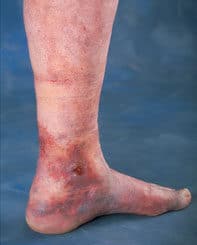Personalized Medical Treatment for Venous Leg Ulcers
Venous leg ulcers, also called stasis ulcers, are one of the most common chronic wounds treated in wound care centers. It is estimated that up to 1.8 million people in the United States are afflicted with venous leg ulcers.
What Are Venous Leg Ulcers?

The most severe manifestation of venous disease is when inadequate blood flow from venous congestion causes weakening of the immune system, namely white blood cells. The weakened immune system and venous congestion combination can cause a local buildup of toxins in the tissues of the legs, most commonly in the inner ankle areas.
Gravity causing venous high pressure can lead to reverse blood circulation in the leg veins. This inflammation then harms the tissues of the skin in the foot, ankle and lower leg. A buildup on the legs can manifest itself by an eruption and breakdown of the skin, or a leg wound. After some time, a small wound may grow to be considerably bigger and more profound.
This wound on the leg, called a venous leg ulcer, commonly appears as shallow injuries between your lower calf and ankle or on your calf and foot, although some can appear on the outer or posterior (back) of the leg. Leg ulcers are often seen with an area of surrounding inflammation, including redness, swelling, and tenderness of the skin and soft tissue. Some patients complain of swelling, achiness, and tiredness in the legs.
In some patients, leg ulcers may heal gradually. In others, leg ulcers last for weeks, months, or even years. If the underlying diseased veins that produce the leg ulcer are not identified or treated, the leg ulcers tend to not heal properly and recur more often. Leg ulcers may also become infected, which can prompt more serious health problems.
This build up can manifest itself by an eruption and breakdown of the skin called an ulcer. Venous disease is the source in the majority of venous leg ulcer patients. These leg ulcers are frequently associated with varicose veins.
What Are the Symptoms of Venous Leg Ulcers?
- Open wound/sore in lower leg around the ankle, most commonly on the inner/inside of the ankle.
- Leg swelling
- Itchiness
- Skin discoloration
- Signs of infection at wound site
What Are Risk Factors for Venous Leg Ulcers?
Risk of leg ulcers is higher for diabetics who have already compromised circulatory systems. Other factors leading to leg ulcers include obesity, aging, injury, family medical history, constant standing for long periods of time and certain medical conditions. People may inherit a tendency for abnormal veins. The elderly and women are having higher risk for leg ulcers than men or more youthful individuals.
Skin discoloration, spider veins and varicose veins are all signs that your circulation is not returning blood to your heart appropriately. General physical action, including exercise, and appropriate eating, can help your circulatory system and may diminish your odds of developing venous leg ulcers.
How Are Venous Leg Ulcers Treated?
Our doctors will carefully map out a personal medical treatment for patients that suffer from venous ulcers. Often the first course of action is compression to relieve built up pressure, but invariably treatment of the offending vein(s) will need to occur. In most cases, ablation of the diseased superficial vein and/or treatment of any perforator or tributary veins that lead to the ulcer will help to re-direct blood flow and alleviate the congestion and clear the toxins. The relief of the pooled blood helps to the deliver fresh blood and nutrients to heal the leg ulcers.
Meet Our Expert DoctorsRequest an Appointment
Our specialists will take the time to answer your questions about venous leg ulcers and our advanced procedures. At Precision VIR, we have expertise in all available minimally invasive techniques. After an initial evaluation, we tailor the correct procedures with patient comfort, safety and maximum effectiveness in mind. To schedule an appointment please call us at 214-382-3200 or complete the form below.
Precision VIR serves the DFW area including Dallas, Fort Worth, Carrollton, Richardson, Garland, Mesquite, Highland Park, University Park, Park Cities, Plano, Frisco, McKinney, Arlington, Irving, Grand Prairie, Denton, Lewisville and all of North Texas.
This information is not a substitute for professional medical advice. Prior to starting any new treatment or questions regarding a medical condition, always seek the advice of your doctor or other qualified health provider.
